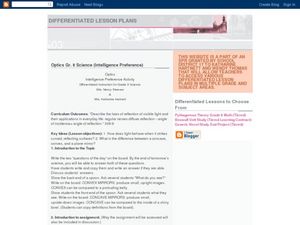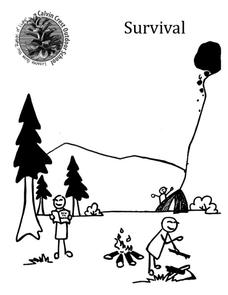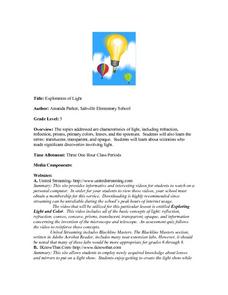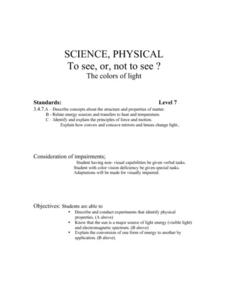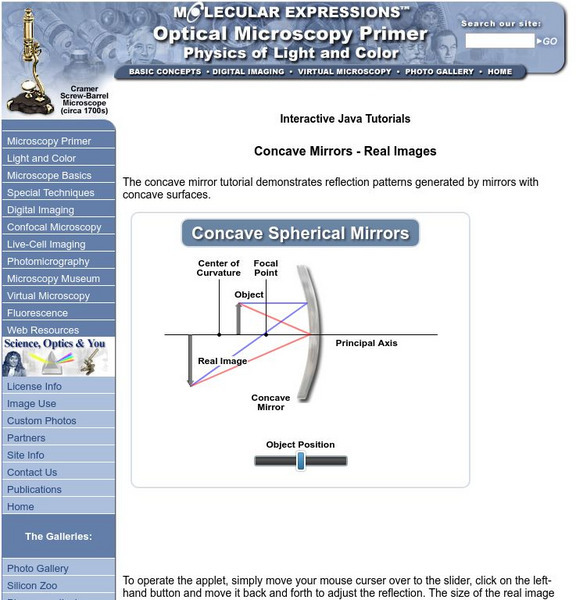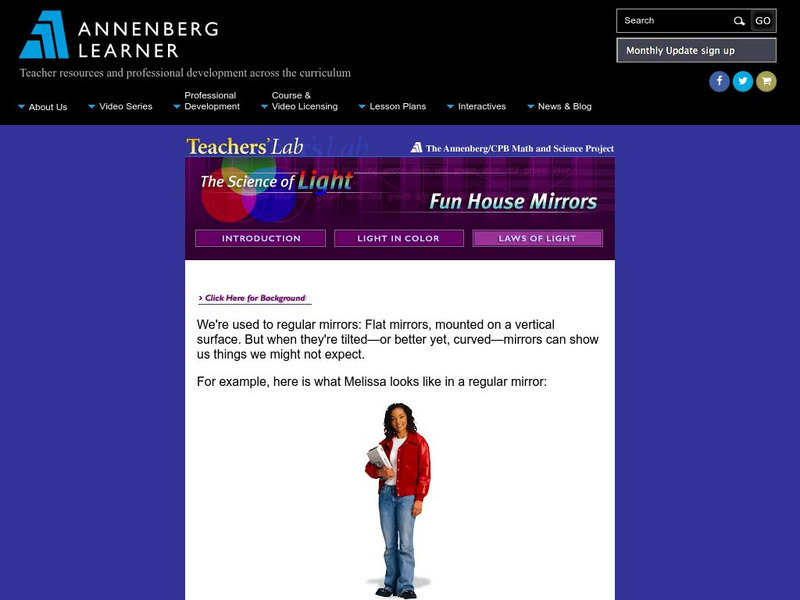Curated OER
Intelligence Preference
Eighth graders describe how light behaves when it strikes a surface. In this physics lesson plan, 8th graders investigate how the different types of mirrors reflect light. They work with their chosen group on a task they selected.
Curated OER
Microscopes, Telescopes, and Cameras
In this lenses worksheet, students will explain how microscopes work by completing 4 short answer questions. Students will compare refracting telescopes with reflecting telescopes by writing the terms given under the correct column. Then...
Curated OER
Light Gathering Power
Students compare and calculate the light gathering power of lenses. They determine the ability of various lenses and mirrors to gather light.
Annenberg Foundation
Poetry of Liberation
How do writers use words to protest injustice, challenge the status quo, and shape their own identities? Individuals watch and discuss a video, read author biographies, write poetry and journals, develop a slideshow, and complete a...
Curated OER
Light - Stop Faking It!
This well-designed presentation covers many important aspects of the science behind light. In it, pupils view slides that have a lot of the important vocabulary associated with science, slides of famous scientists who made important...
Calvin Crest Outdoor School
Survival
Equip young campers with important survival knowledge with a set of engaging lessons. Teammates work together to complete three outdoor activities, which include building a shelter, starting a campfire, and finding directions in the...
Texas State Energy Conservation Office
Investigation: Building a Parabolic-Trough Collector
Amateurs of alternative energy build a mini parabolic-trough solar energy collector and use it to heat water. Temperature is recorded over a three-minute period and the data is graphed and analyzed. Note that in order to paint aquarium...
Curated OER
Applied Science - Technology (5A) Lab
Fifth graders explore electromagnetic waves and light. In this light lesson, 5th graders draw the parts of a wave of the electromagnetic spectrum. They compare a flashlight to a laser to see how the light looks when shined through...
Curated OER
Applied Science - Physics (5B) Post Lab
Fifth graders analyze optical images. in this optical lesson, 5th graders look at how light reflects and refracts. They discuss different types of lenses and how they change the picture that is taken.
Curated OER
Exploration of Light
Fifth graders observe the video, Exploring Light and Color. They access a website to create their own light show. They conduct lab experiments to investigate refraction, reflection,and other light-related topics.
Curated OER
Microscopes and Telescopes
Students analyze a microscope and study what they do. In this investigative instructional activity students study how microscopes were first invented, and how ray diagrams are used in conjunction.
Curated OER
To See or Not to See: The Colors of Light
Seventh graders describe and conduct an experiment that identifies the physical properties of light. They explore sources of visible light and an electromagnetic spectrum. Students explain the conversion of one form of energy to another.
Curated OER
Radiation From Space
In this space activity, students will review different aspects of light, sound, and radio waves in space and the use of different types of telescopes. This activity has 17 fill in the blank statements.
Curated OER
Reflection & Refraction
In this online interactive reflection and refraction worksheet, students respond to 7 multiple choice and fill in the blank questions regarding the information included in the provided paragraphs.
Curated OER
Pinhole Viewer
Students make a pinhole viewer to demonstrate how it inverts light passing through it which produces inverted images.
Curated OER
How Light Moves
Students study the movement of light. In this light lesson, students work in groups to participate in a light and shadow walk around their neighborhood. Students brainstorm rules for light movement and watch videos about light travel,...
Physics Classroom
The Physics Classroom: Reflection/ray Model of Light: Convex Mirror Images
Students explore three different ray diagrams for objects positioned at different locations along the principal axis in a convex mirror.
Florida State University
Florida State University: Microscopy Primer: Concave Mirrors: Real Images
Florida State University offers an interactive Java applet demonstrating the object-image relationships for a concave mirror. The position of the object can be dragged along the principal axis and the location, orientation, and size of...
CK-12 Foundation
Ck 12: Concave and Convex Mirrors
[Free Registration/Login may be required to access all resource tools.] In this lesson, students learn how to draw ray diagrams and to solve problems for concave and convex mirrors.
Physics Classroom
The Physics Classroom: Ray Diagrams for Concave Mirrors Case A
Ray diagrams are useful tools for determining the location of an image as produced by a concave mirror. All concave and convex mirror ray diagrams can be constructed from knowledge of the behavior of two rays. Learn here about ray diagrams.
Annenberg Foundation
Annenberg Learner: Fun House Mirrors
Explore the effect of concave and convex mirrors. Combine concave and convex mirrors to design a fun house mirror that will create the distorted pictures of Melissa and Sam.
Physics Classroom
The Physics Classroom: Ray Diagrams for Concave Mirrors Case B
Ray diagrams are useful tools for determining the location of an image as produced by a concave mirror. Of all the rays which emanate from the top of the object arrow and are incident to the mirror, there are two rays whose behavior at...
Physics Classroom
The Physics Classroom: Ray Diagrams for Concave Mirrors Case D
Ray diagrams are useful tools for determining the location of an image as produced by a concave mirror. Of all the rays which emanate from the top of the object arrow and are incident to the mirror, there are two rays whose behavior at...
Georgia State University
Georgia State University: Hyper Physics: Mirror Instruments
This site from Georgia State University discusses the means by which mirrors and lenses are combined to produce an optical instrument which accomplishes a specific purpose. Good illustrations.
